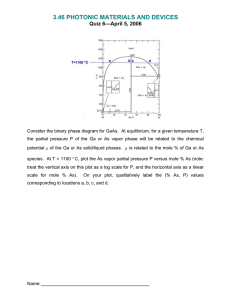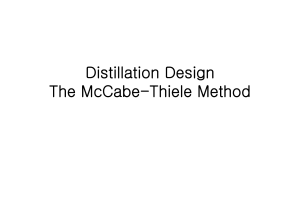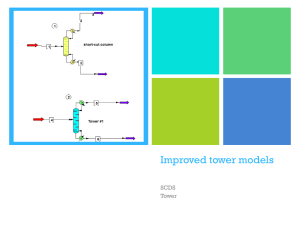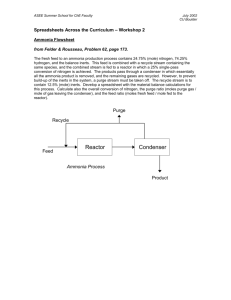Binary Distillation
advertisement
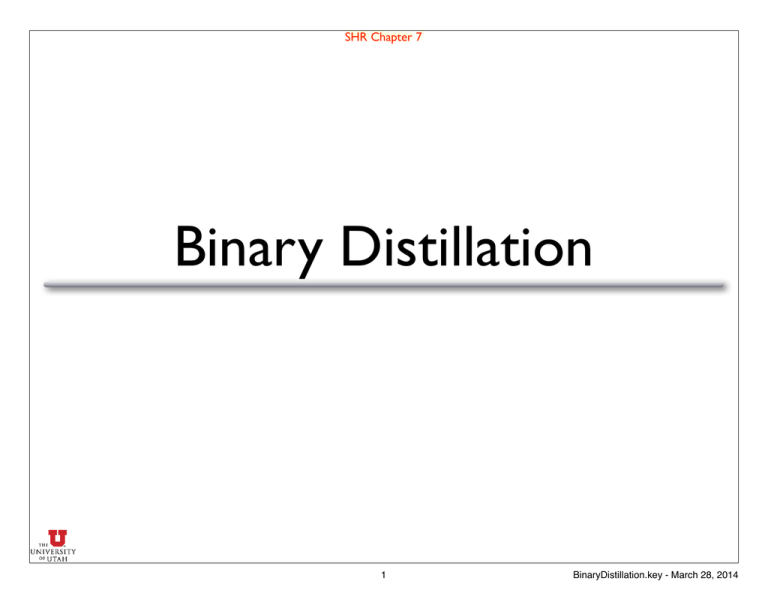
SHR Chapter 7
Binary Distillation
1
BinaryDistillation.key - March 28, 2014
SHR §7.1
Introduction
st
Dates back to 1 century AD
• first used in a batch mode (distillate changes in time)
Goal: separate “heavy key” (less volatile) from
“light key” (more volatile) by exploiting α≠1.
• for α≫1 or α≪1, this can be done very effectively
unless an azeotrope exists (where α=1).
‣ then we recover the azeotrope and the light or heavy key,
depending on which side the feed lies.
th
• By 16 century, multiple stages were in use to
improve separation.
By 1976, distillation accounted for nearly 3% of
the US energy consumption!
• mostly in petroleum refineries
Binary distillation is simplest & most wellunderstood.
• we will limit our discussion to binary distillation
Third Law of Thermo - typically low
thermodynamic efficiency.
2
BinaryDistillation.key - March 28, 2014
Design Considerations
Operating pressure - “knob 1”
• below ambient pressure requires vacuum operation
• many things may influence choice of operating pressure
‣ Thermo: azeotrope formation, α, etc.
‣ Column operating temperature range (avoiding reactions,
corrosion, etc.)
• most analyses do not account for pressure variation
V
L
F
through the column
Operating temperature - “knob 2”
• Reboiler & Condenser:
D
V
B
L
‣ Bottoms above ambient requires additional energy input to the
reboiler
‣ Distillate below ambient requires energy removal from the
condenser.
• Thermodynamics: critical points of fluids
3
BinaryDistillation.key - March 28, 2014
Batch Distillation
Conceptually, follows
the T-x-y diagram.
More rigorous analysis
in SHR chapter 13
4
BinaryDistillation.key - March 28, 2014
SHR §7.2
The McCabe-Thiele
Graphical Method
1925
Continuous (staged) distillation
5
BinaryDistillation.key - March 28, 2014
Nomenclature
Results
Specifications
F
total (molar) feed rate
D
Distillate (molar) flow rate
z
LK mole fraction in feed
B
Bottoms (molar) flow rate
P
Column operating pressure
N
minimum number of stages
x
LK mole fraction in distillate
R
minimum reflux flow rate
x
LK mole fraction in bottoms
V
Boilup ratio
reflux ratio
N
Number of equilibrium stages
R/R
Feed phase condition
Feed stage location
VLE data (y/x plot)
Type of condenser (partial/total)
Stage compositions (
Type of reboiler (partial/total)
• “Light Key” (LK) - more volatile component
• “Heavy Key” (HK) - less volatile component
6
BinaryDistillation.key - March 28, 2014
Preliminaries
Rectifying section - like an absorber
• Feed & reboiler supply vapor
• Condenser supplies liquid
Stripping section - like a stripper
• Feed & condenser supply liquid
• Reboiler supplies vapor
overall mole balance: F = D + B
light-key mole balance: F zF = xD D + xB B
combine to eliminate
D=F
B & solve for D:
7
✓
zF
xD
xB
xB
◆
BinaryDistillation.key - March 28, 2014
SHR §7.2.1
Rectifying Section Operating Line
Overall mole balance: V = L + D
Light key mole balance: V yn+1 = Lxn + DxD
yn+1 =
L
D
xn + xD
V
V
relates light-key compositions in passing streams (streams on a stage are assumed to be in equilibrium)
If L and V are constant, then this is a straight line.
The “McCabe-Thiele Assumptions”
• Both components have equal and constant molar
enthalpies of vaporization (latent heats).
• Sensible heat, CpΔT, is negligible compared to latent heat.
• Column is insulated (no heat loss on each stage).
• Column pressure is constant (thermodynamics can be
done at a single pressure).
Big assumptions, but allow for simple analysis, since
L and V are constant under these assumptions.
li
ing
ne
rat
e
op
L/D
L
L
R
L reflux
R⌘
=
=L
=
D ratio
V
L+D
/D + D/D
R+1
D
1
✓
◆
✓
◆
=
1
R
V
R+1
x+
xD
y=
R+1
R+1
8
BinaryDistillation.key - March 28, 2014
Range of Reflux Ratios
y=
0
•
•
L
D
x + xD
V
V
✓
L
R
=
V
R+1
R=
◆
L
D
1 because 0 R 1
What happens at R = 0?
What happens at R = ∞?
What is the minimum R that allows separation?
(We will answer this question shortly)
9
BinaryDistillation.key - March 28, 2014
SHR §7.2.2
Stripping Section Operating Line
Overall mole balance: L = V + D
Light key mole balance: Lxm = V ym+1 + BxB
McCabe-Thiele assumptions
have been applied.
The feed stage material balance relates L and V to L and V
1
VB
◆
xB
lin
V boilup
B ratio
ing
VB ⌘
x
✓
relates light-key compositions in passing streams (streams on a stage are assumed to be in equilibrium)
e
VB + 1
VB
◆
B
xB
V
rat
y=
✓
L
xm
V
op
e
ym+1 =
10
BinaryDistillation.key - March 28, 2014
SHR §7.2.3
Feed Stage & the “q-Line”
rectifying
section
stripping
section
q=
q=
L
subcooled liquid
saturated liquid
q>1
q=1
L
F
F
vapor
hsat.
F
vapor
hsat.
F
saturated vapor
superheated vapor
q=0
q<0
V liquid flow increase across feed
V
=1+
partially vaporized
q = LF/F
rate normalized by feed rate.
hF
liquid
hsat.
F
Operating lines & qline must intersect at
a single point.
∴ cannot specify q, VB
and R independently.
11
BinaryDistillation.key - March 28, 2014
More on the q-line
rectifying section:
stripping section:
L
y= x
V
L
D
y = x + xD
V
V
B
xB
V
q=
L
L
F
=1+
V
V
F
subtract
y V
V =x L
L + DxD + BxB
|
{z
}
F zF
y
✓
V
F
y (1
V
◆
=
✓
L
L
◆
x + zF
F
q) =
qx + zF
✓
◆
q
zF
x
y =
q 1
q 1
Typically the feed condition is
known (specifying q).
Then we can choose VB or R.
Note: specifying R implies VB.
12
BinaryDistillation.key - March 28, 2014
SHR §7.2.4
Feed Stage & Number of Stages
too low
just right
too high
Locate feed stage nearest to the intersection of
the operating lines & q-line as possible (just after
the horizontal line on the staircase passes “P”
13
BinaryDistillation.key - March 28, 2014
Partial Reboilers & Condensers
Total Reboiler:
• all liquid is turned back to vapor
Partial reboiler:
• bottoms product is liquid, boilup is vapor
• This is another equilibrium stage!
• very common...
Total condenser:
• all vapor is condensed back to liquid
Partial condenser:
• distillate is vapor, reflux is liquid
• This is another equilibrium stage!
14
D
V
L
F
V
B
L
BinaryDistillation.key - March 28, 2014
SHR §7.2.4
Limiting Cases: Rmin, Nmin.
D
V
“Total reflux”
•
•
•
•
•
“Minimum reflux”
• N = ∞.
L
R = ∞, VB = ∞.
L = V, D = B = F = 0.
F = 0, N = Nmin.
y = x is operating line.
No product...
Rmin
Rmin + 1
(L/V )min
Rmin =
1 (L/V )min
⇥
⇤
L
(VB )min =
/V max 1
(L/V )min =
F
V
B
L
1.0
1.0
1.0
1
“pinch
point”
ve
cur
y
3
y
x=
x
y
x=
x = zF
x = xD
x = xB
x = xB
1.0
ilibr
ium
x=
equ
y
equ
y
ilibr
ium
cur
ve
2
0
1
0
x
higher operating costs
y
x = zF
x = xD
x = xD
x = xB
1.0
0
x
1.0
higher capital costs
15
BinaryDistillation.key - March 28, 2014
SHR §7.2.4
Perfect Separation - Another “Limiting Case”
operating line = Rmin/(Rmin+1).
1.0
y
Perfect separation: xB = 0, xD = 1.
Pinch points form in each section
of the column.
Theoretical value for minimum
reflux ratio and boilup to achieve
perfect separation.
To find this:
• Obtain x-y data from thermo.
• Determine q-line
• Determine slope of rectifying
x=
y
x = zF
0
For saturated liquid feed, Rmin =
16
x
1.0
1
zF (↵ 1)
BinaryDistillation.key - March 28, 2014
Example
We want to separate a mixture of n-heptane and n-octane using distillation at
atmospheric pressure.
If the feed is 40 mole% n-heptane as a saturated vapor, determine the
minimum reflux ratio and minimum number of stages required to obtain
product streams with 95% and 5% n-heptane.
D
V
Known:
Needed:
• xD = 0.95
• K-values (equilibrium curve)
• xB = 0.05
• q-line • zF = 0.4, saturated vapor
• operating lines
L
F
V
B
L
17
BinaryDistillation.key - March 28, 2014
